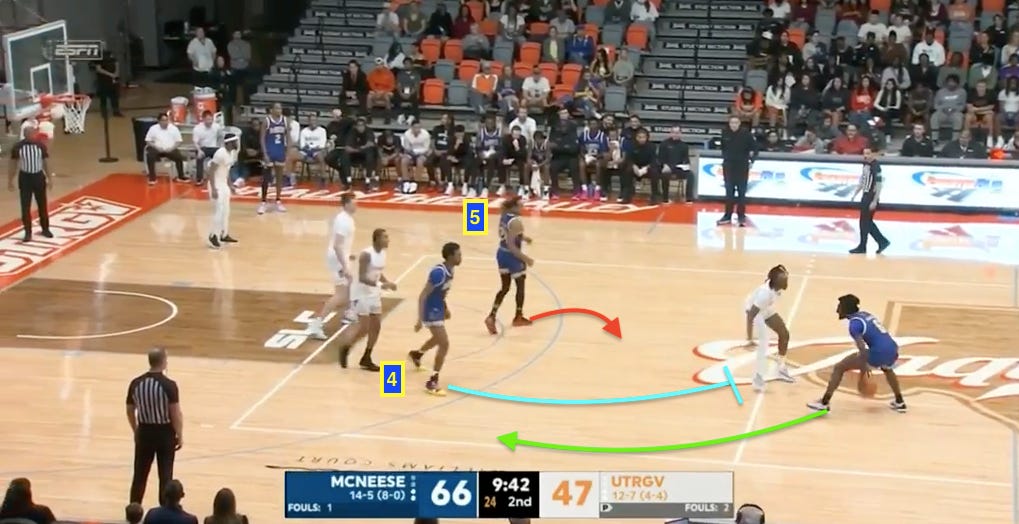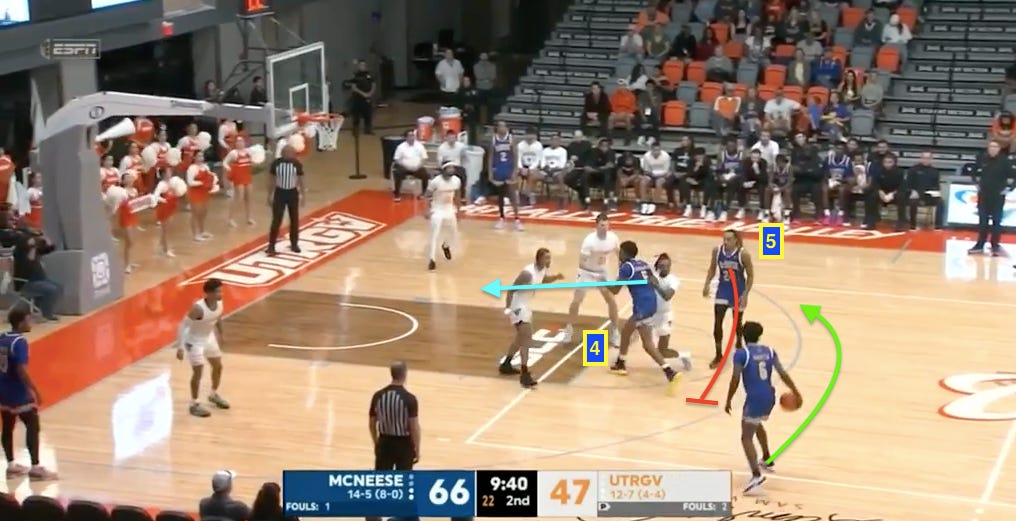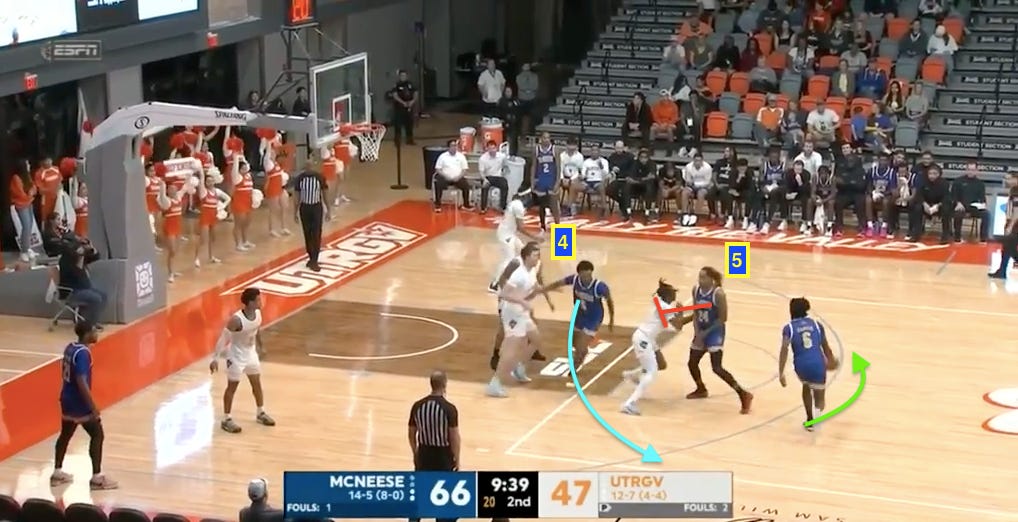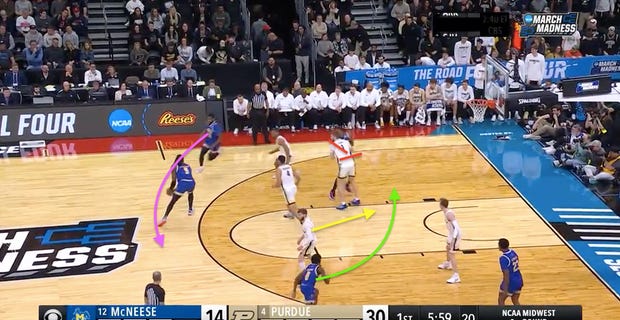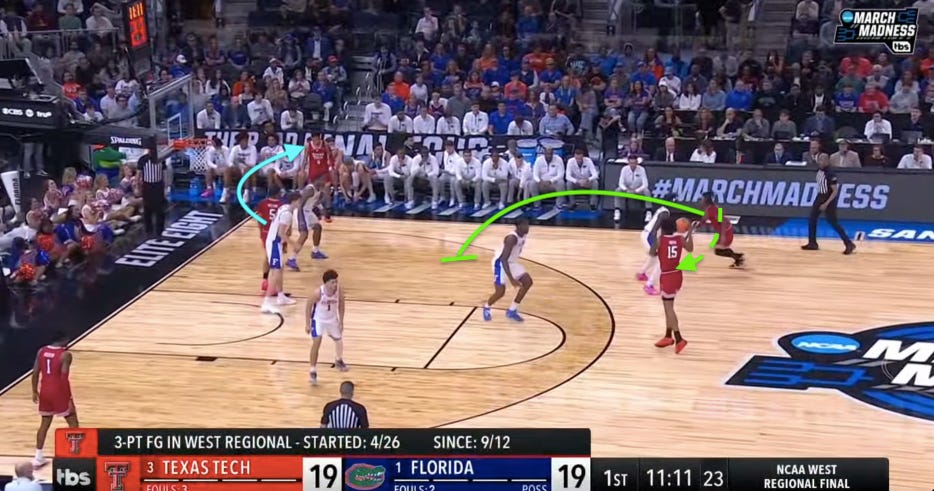Breaking down 2 of Will Wade's go-to ball screen sets, plus a conversation with NC State Assistant GM Patrick Stacy
A quick look at how Will Wade gets buckets out of ball screens, plus a numbers-minded convo with Patrick Stacy from NC State.
Back in March, I took an in-depth look at Will Wade’s offense for Pack Pride, breaking down his core pick-and-roll actions and exploring elements of his 5-out system.
Now that rosters are fully set, and there’s a better understanding of how pieces will fit together in certain schemes, I’d like to take a deeper look into two of those ball screen sets in this space: “Horns Twist Leak” and “Angle Pop.”
Also, I recently had the opportunity to speak with Patrick Stacy, NC State men’s basketball’s new Assistant General Manager. A respected voice in the basketball analytics space, Stacy shared insights into how the program is using data to inform its decision-making. The video of our conversation is embedded below — be sure to check it out.
Horns Twist Leak
One of Wade's primary play calls out of a Horns set features a Roll-Replace action, where the screener rolls from the perimeter to the paint after a pick-and-roll, while a second off-ball player simultaneously relocates (“replaces”) from the paint to the perimeter.
I refer to this play as "Horns Twist Leak." It’s an excellent set to run with a stretch big and works well against a variety of pick-and-roll coverages. The action begins in a traditional Horns alignment, with two shooters spaced in the corners and the two bigs positioned at the elbows.
To start, the point guard will pick a side of the floor and dribble in that direction, working off the screen of one of the two bigs. This first screen will be set by the stretch-big, a tall shooter who will eventually be featured in the “Replace” action. For McNeese State last season, this was Joe Charles, a 6-foot-9 power forward who shot 35.3 percent on 133 3-point attempts in the 2024-25 campaign.
After using the initial screen, the point guard reverses direction as the second big — positioned at the elbow — lifts to set a second ball screen.
The “Twist” action brings the guard back toward the middle and ultimately to the original side, creating space and shifting the defense. The “Leak” refers to the subsequent Replace action.
As the 5 (Christian Shumate) screens and rolls, the 4 (Charles) lifts from the paint back beyond the 3-point arc. That’s the beauty of this action: the inside-out movement shifts the defense, preserves 4-out-1-in spacing, creates an extra kick-out option and opens up a double gap for the point guard to attack.
More specifically, the Roll-Replace action is designed to put pressure on the tag defender, forcing a difficult choice between covering the 4 or the 5. If the 4 replaces into open space and is a legitimate threat from deep, his defender is caught in a bind. Stay home on the shooter, and you risk giving up a roll to the rim — the highest-value shot in basketball. Help on the roller, and you leave a capable shooter open on the perimeter, which is what happens here against UTRGV. Both defensive bigs sag in the paint; Charles drills a clean look from deep.
Now, here’s the same setup against SFA — with the offense again bending the defense and pressuring multiple levels of the floor: rim and from beyond the arc. As the help defender hangs in the paint to tag the 5, Bryant Selebangue (9), on the roll, Charles leaks back up the floor. SFA switches on the ball, but Charles (5) is open for the kick-out 3-ball.
From the 2021-22 season: here’s Wade’s LSU team running the same Horns Twist Leak set against Ohio — with Darius Days (4), their stretch-4 (career 35.3 3P%) replacing back up the floor for an open 3-point attempt, while Efton Reid (15) rolls.
Assuming NC State goes to this set in the 2025-26 season, it’s easy to see things working with 6-foot-6, 225-pound Darrion Williams (career 37.9 3P%) or the 6-foot-9 Jerry Deng (career 36.8 3P%), two stretch-forwards, running the replace action, while Ven-Allen Lubin, Scottie Ebube or Zymicah Wilkins roll to the rim.
The Roll-Replace action generates looks for more than just the 4 or the 5. It can also scramble matchups and create driving lanes for the 1, which is exactly what happens here against Alabama. Coming out of a timeout just before halftime, point guard Alyn Breed (7) dribbles to the right side of the floor, using a pick from Charles. He then reverses direction, coming back to the middle off a screen from Shumate. Alabama initially keeps the ball in front, but as Charles leaks back up the floor, he slips behind Breed’s defender, All-SEC guard Mark Sears (1). That brief blur action, combined with a hang dribble from Breed, throws Sears off-balance and opens a lane to the rim.
This Horns Twist set with Roll-Replace action is a highly-accessible contemporary play design out of Horns. Turn your TV on during basketball season and there’s good chance you’ll see multiple teams break it out on a nightly basis, regardless of level. Duke, for instance, ran it a lot during Jon Scheyer’s first season as head coach — a way to integrate a stretch, playmaking big in Kyle Filipowski (30) with the rim-running lob threat of Dereck Lively (1).
When Josh Pastner was at Georgia Tech, the Yellow Jackets routinely went to this action to create scoring opportunities for Jose Alvarado and Michael Devoe. From this 2021 game: Alvarado gets a switch and then gets to his spot for a pull-up 3-pointer.
Angle Pop
With more teams incorporating 5-out shooting and spacing into their offenses, the "Angle Pop" has emerged as one of the most popular half-court actions in today’s game.
The play begins with one of the bigs — usually the 5 — setting a ball screen on the edges of the middle third of the floor, positioned closer to the slot than the top of the key. The three players not involved in the action are spaced with one in the opposite slot and the other two in the corners. The ball handler dribbles off the screen toward the sideline, while the big pops to the middle of the floor. The 5 often sets a flat ball screen, with his back parallel to the baseline.
When the ball is swung to the middle of the floor to the 5 on the pop, it triggers weak-side action. The 4 will either lift to the wing and then set a down screen for the guard in the weak-side corner, or he'll cut to the basket on a 45-degree angle.
This action is simple but effective, using 5-out spacing to shift the defense before initiating second-side action — with some built-in advantage.
As Sincere Parker (21) comes off the dribble handoff with Selebangue, point guard T'Johnn Brown (0) makes a 45-cut, pulling Braden Smith (3) out of help position and opening up another gap. That creates space for Parker to attack off the bounce, with Purdue center Trey Kaufman-Renn (4) in drop coverage.
Here’s the same action from earlier in the game against Purdue. This time, Purdue center Will Berg (44) starts in drop coverage but does a nice job switching on the fly to Parker, who gets into the lane but is cut off before reaching the restricted area. Instead, he’s forced to settle for a tough fadeaway jumper over the 7-foot-2 Berg's contest.
Wade’s offense also uses the Angle Pop to create backdoor opportunities on the weak side — where this action can be especially effective. The pop isn’t necessarily designed to generate a 3-point look for a non-shooter at the 5; it’s about forcing the defense to rotate in response to the ball screen, then quickly shifting the point of attack to the opposite side.
On this possession, Copeland and Selebangue run the Angle Pop. With Texas A&M Corpus Christi sending two defenders at the ball, Selebangue slips into the middle of the floor, receives a pass from Copeland and dribbles into open space with his defender trailing. As that unfolds, Murray cuts through the paint from left to right, effectively clearing out the side of the floor — setting the stage for a backdoor opportunity. Parker walks his man up, then snaps into a sharp V-cut along the baseline for the backdoor look.
McNeese State ran this same action later in the second half, but Parker couldn’t finish the dunk after another well-placed backdoor pass from Selebangue.
With this angled ball screen action, if the first screen doesn’t create an advantage, the 5 can flip his hips and re-screen. On this possession against Clemson, instead of popping after the re-screen, Selebangue dives to the rim. Clemson initially has the roll covered well, but Chauncey Wiggins (7) gets caught denying Brandon Murray (23) the ball in the strong-side corner. Murray and Copeland recognize it instantly, and the two veterans connect on a backdoor cut for the finish.
NC State has the ingredients to tap into this action in the 2025-26 season. Darrion Williams quarterbacked a Top 10 offense last year at Texas Tech, where one of the Red Raiders’ go-to actions was the Angle Pop — often run with a few different variations.
At times, Tech used Williams, the 4, as the screen setter to get him directly involved in the action.
Here against Arizona, Williams (5) sets the screen and pops with Elijah Hawkins (3), while the 5, JT Toppin (15), spaces to the strong-side corner. Arizona’s power forward Tobe Awaka (30) plays drop coverage, giving Williams plenty of space in the middle third of the floor.
On the weak side, Chance McMillian (0) makes a 45-cut, though it’s not needed. Awaka is too deep to recover in time. Williams rises and buries the open 3.
A few minutes later, TTU runs the same set: Williams sets the angled ball screen for Hawkins and pops to the middle. McMillian performs the 45-cut. After giving up the earlier 3-ball to Williams, Awaka sticks closer this possession. Williams receives the pass from Hawkins while McMillian cuts through the lane — thus clearing out the weak-side for two-man game between Williams and combo guard Christian Anderson (4). As Williams initiates the DHO with Anderson, Awaka is back in the drop, which puts pressure on KJ Lewis (5) to fight over the top. Anderson draws a foul on Lewis.
Finally, from the NCAA Tournament matchup vs. Florida: Texas Tech runs Angle Pop on an after-timeout (ATO) possession, this time with Toppin as the screener. Williams starts near the left wing but cuts down into the paint as the play develops, giving TTU three players spaced along the baseline. As Toppin receives the pass in the middle third, Williams faces McMillian in the right corner — seemingly setting up for a Flex screen.
However, the Red Raiders come to the table with something different. Instead of having Williams screen for McMillian, Texas Tech launch Gut Zoom action in the middle third of the floor. After passing off to Toppin, Hawkins cuts toward the right elbow and sets a down screen for Williams on Florida forward/center Alex Condon (21). Williams cuts off the down screen and moves directly into the handoff with Toppin, thus creating the Zoom action up the middle (“Gut”) of the lane. Florida center Rueben Chinyelu (9), an excellent defender switches out on Williams. TTU flows into the next progression, which features Toppin lifting back up to set a ball screen for Williams. Once again, the Gators switch, placing Condon back on Williams; however, the powerful point forward is able to get to his spot and score at the rim.
Talking with NC State Assistant GM Patrick Stacy
As Wade assembled his staff at NC State, the program expanded its infrastructure with key hires, including Assistant General Manager Patrick Stacy. A Loyola University graduate, Stacy served as an analytics manager for the school’s 2018 Final Four team. He later worked in finance and founded Jam Basketball Intelligence, a scouting service that gained industry recognition. For the 2024-25 season, Stacy joined Sunny Wicks’ staff at Wyoming before being brought to Raleigh by Wade.
For the debut of a video podcast series I launched at Pack Pride — The Deep Drop with Brian Geisinger — Stacy joined me for a detailed conversation on the evolution of analytics in college basketball, including how NC State uses data to scout opponents and build rosters, best practices for communicating that information to coaches and players, insights into various pick-and-roll coverages and the return of Paul McNeil Jr. — plus plenty more. There’s a lot of good stuff in here. Please give it a listen!


